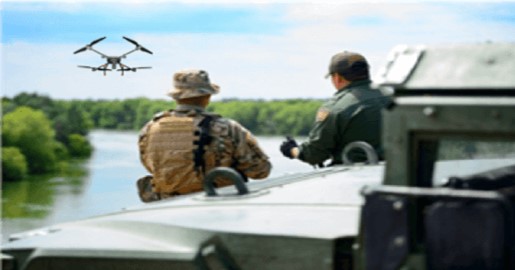The Role of Drones in Border Surveillance and National Security
Drones have emerged as a game-changer in border surveillance and national security. With their ability to fly over vast areas, capture high-resolution imagery, and operate in challenging terrains, drones are revolutionizing the way countries monitor and protect their borders. Governments and defense agencies worldwide are increasingly integrating UAVs (Unmanned Aerial Vehicles) into their security frameworks to enhance situational awareness and respond swiftly to threats.
Introduction
Drones have emerged as a game-changer in border surveillance and national security. With their ability to fly over vast areas, capture high-resolution imagery, and operate in challenging terrains, drones are revolutionizing the way countries monitor and protect their borders. Governments and defense agencies worldwide are increasingly integrating UAVs (Unmanned Aerial Vehicles) into their security frameworks to enhance situational awareness and respond swiftly to threats.
How Drones Enhance Border Surveillance
Traditional border monitoring methods rely on stationary cameras, patrol vehicles, and human personnel. However, these methods have limitations in covering remote and inaccessible regions. Drones, equipped with advanced sensors, infrared cameras, and AI-based tracking systems, can provide real-time surveillance, reducing blind spots along national borders. They can detect illegal crossings, smuggling activities, and unauthorized movements, allowing security forces to take immediate action.
Types of Drones Used in Border Security
Different types of drones serve various roles in national security. Fixed-wing drones, such as the MQ-9 Reaper, are used for long-duration surveillance over large areas. Rotary-wing drones, like quadcopters, provide flexible and close-range monitoring of specific locations. Some advanced UAVs are equipped with autonomous flight capabilities, allowing them to patrol pre-programmed routes without direct human intervention. These diverse drone types help authorities maintain a robust security infrastructure.
Integration of AI and Machine Learning
Artificial intelligence (AI) and machine learning play a crucial role in enhancing drone capabilities for border security. AI-powered drones can analyze vast amounts of data from their cameras and sensors, identifying potential threats such as suspicious movements or unusual activity. Facial recognition and object detection technologies further improve the accuracy of threat identification, reducing human workload and increasing response efficiency.
Drones in Maritime Border Security
Maritime borders are particularly difficult to monitor due to their vastness and unpredictable conditions. Drones are being deployed to patrol coastal waters, detect illegal fishing, prevent smuggling, and counter potential threats from hostile forces. Surveillance drones can relay real-time data to coast guards, helping them respond quickly to emergencies or intrusions.
Advantages of Using Drones in Border Surveillance
The use of drones in border security offers several advantages:
Cost-Effective: Drones require less manpower and fewer operational costs compared to traditional patrolling methods.
24/7 Surveillance: Unlike human personnel, drones can operate continuously, even in extreme weather conditions.
Rapid Deployment: Drones can be deployed instantly to areas where security threats arise.
Enhanced Safety: Security forces can use drones to assess potentially dangerous situations before sending personnel into high-risk areas.
Challenges and Limitations
Despite their benefits, drones also face several challenges in border surveillance. Battery life and operational range limitations can restrict their endurance. Additionally, drones are vulnerable to hacking and electronic warfare, which could compromise security operations. Harsh weather conditions, such as strong winds and storms, can also impact drone performance. Addressing these challenges requires continuous technological advancements and investment in drone defense systems.
Future of Drones in National Security
The future of drone technology in border surveillance is promising. With advancements in artificial intelligence, longer battery life, and stealth capabilities, drones will continue to play a crucial role in securing national borders. Integration with satellite networks and improved autonomous capabilities will further enhance their efficiency. Governments worldwide are expected to increase investments in drone-based security systems, making them a permanent fixture in national defense strategies.
Conclusion
Drones have transformed border surveillance and national security by providing real-time intelligence, improving efficiency, and enhancing response capabilities. As technology advances, their role will continue to expand, ensuring greater protection against illegal activities and security threats. While challenges remain, ongoing research and development will help overcome these hurdles, making drones an indispensable tool for national defense.
.png)






Leave a Comment
Your email address will not be published. Required fields are marked *